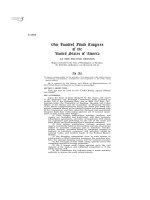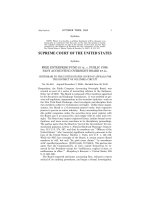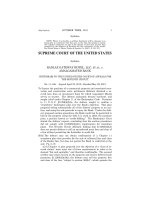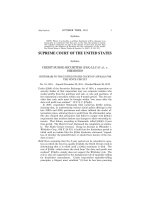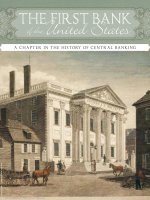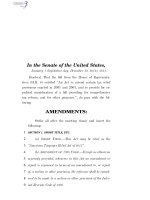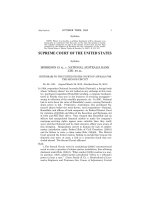Implementation of New Accounting,,Standards of the United States Washington _part6 ppt
Bạn đang xem bản rút gọn của tài liệu. Xem và tải ngay bản đầy đủ của tài liệu tại đây (1.46 MB, 11 trang )
, ~~
I
I
STEWARDSHIP INFORMATION
49
United States. Government
Stewardship Information
for the Year Ended September 30, 1998
(Unaudited)
When acquired, “Stewardshi,p as-
sets” are treated as expenses in the fi-
nancial statements. This section pro-
vides more detailed,stewardship
information on these resources to high-
light their long-term benefit and to
The Federal Government holds
demonstrate accountability. This infor-
“Stewardship assets” for the benefit of
mation facilitates the understanding of
the Nation. Because the Government
tl.,
e operations and financial condition
has been entrusted with, and made ac-
of the Government.
countable for, these resources and re-
sponsibilities, they are recognized in
the Financial Report of the United
States Government.
The Department of Defense (DOD) owns and uses
“National defense assets” to accomplish military mis-
sions, such as war, operations short of war, training,
peacekeeping and supporting civilian authorities dur-
ing civil emergencies.
These assets divide’into two categories: weapons
systems and support principal end items. ‘Weapon ’
systems refer to military equipment that launch, re-
lease, carry, or fire ordnance; and/or equipment that
carries weapon systems related property, equipment,’
material or personnel. Support principal end items
consist of items acquired to support weapon systems
that ultimately may be incorporated into weapon sys-
tems. Examples of these items include aircraft en-
gines, tank engines, aircraft radar, ship sonar,
uninstalled missile motors, missile control panels,
gun mounts, gun turrets and guidance systems.
The Department of
Defense (DOD) owns ,and.
a uses ‘National defense
assets’ to accomplish
mllltary missions, such as
war, operations short of’
war, training, C
peacekeeping qnd
supporting ciVilian
authorities during civil
einergeilcies.”
This is trial version
www.adultpdf.com
50
STEWARDSHIP INFoF~~~A-~Io~~
,._ ‘,
The DOD’s property systems infor- fi’ed oi .ub&aded,“appiopriate
mation, listed in the National Defense
modifications will be made to re,tiort
Assets table, does not capture and/or
retain addition and deletiqn data;
additions
and
deletions separat$y.
( The quzintities of national defense
therefore, DOD could not report sepa- assets presented reflect the sum of the
rately such amounts. The report re-
quantities reported by the Army,
fiects the net amount betw.een the
Navy, Air Force and the Marine
;‘.
:
.’ ,’
&sets. At t&es of wktr, Coast Gutid
a&ets.are under the direction of
DOD, but in times of peace, they are
under the Department of Transporta-
tion (Transportation). Each of the
miiitary services’ financial state-
ments presents additionai informa-
Qpening and closing balances. 4s. Corps. Natiqnal defense assets do not tion, on national defense assets.
DOD’s property systems are modi- include Coast ,Guard ships and other ’
2
I’ ‘i”
National Defense Assets as of September 30
(In number of systems or items)
Balance as tif Additions/ ,Balance as of
Octciber 1,1997 (Deletkitis) September 30,1998
Aircraft:
Combat . . . . . . . . . . . . . . . . . .
Airlift. . . . . . . . . . . . . . . . . . . .
Other aircraft . . . . . . . . . . . . . .
Ships:
9,047
2,380 ‘- ’
8,916
(434) 8,613
(62)
2,318
(857) . 8,059
Submarines . . . . . . . . . . . . . . .
137 (14) 123
Aircraft carriers. . . . . . . . . . . . .
16 2 18
Surface combatants . . . . . . . . .
229 2. '231
Amphibious warfare,ships , . . .‘,
78 5 83
Mine warfare ships. . . . . , . . . .
34 38
Support ships. . . . . . . . . .’ . . . .
238
pi
Ii28
Other ships . . . . . . . . ‘. . . . .‘. ,
Small boats. . . . . . . . . . . .‘:
,i,2&
3,237 :
@a
1,147
(684)
2,553
*.
Mlssiles:
Ballistic missiles . . . . . . . . . . .
Other missiles . . . . . . . . . . . . .
3,905 /
., (652)
3,253
,*. ” .’ k
725,346
‘
Combat Vehicles:
: ,i ,(
.’
.’ ,,
_ .>,
Tanks . . . . . . . . . . . . . . ,. . : ., . :
10,889, ,(827) .!,
10,062
Other combat vehicles . . . . . . .
43,844 :- ):.’ (6;360) 37,484
; _,,:
Space Syqtems:
,.
Satellites. . . . . . . . . .,. ., : . . ‘. .
69‘ .‘I’ 9 78
Other Weapon Systems:
,,
:
Torpedoes . . . , . . ; . . . . . . . . . ,
7,436 : 1,050 8,486
Otherweapons
13,490 (1,,696) 11,794
‘,
* The beginning of the year amount and additions and deletions were not available from all sources.
(_ .I
This is trial version
www.adultpdf.com
STEWARDSHIP INFORMATION 5 1.
I
I
,
rl
“Mission suppoti assets” include
various types of military equipment,
such as ordnance Support equipment,
vehicular equipment, electronics
Z L a ^^ _- :^^L:^-v.
equipment.;W&apon systems, $~ppoti,.
daptu& the ‘full &st requirti(l’by
ti&$prdpei?y.:inClude~ ammuhition .: SPF+SNumber.4 and will, ?ot, for
bunk,ers and’missi!e: di10~. jn’.aFtive ?. ,p~qy yearr; Therefqre,, @e~amoGxit~,
u&e, ‘. ‘I :, .: ;“;, ./ ,
repbrte’d hi this report repfeserif ‘the
Recently, the requirements were
DOD’s annual disbursements for
‘modified’fok repofting acquisition
each category of National Defense
costs of liational defense assets to re-
Assets.
quire the full cost in accol;dance with The investment amounts in Na-
the Statement of Federal Financial tional Defense Assets, presented in
Accounting Standards (SFFAS) this re’pdrt reflect the sum of invest:
Number 4. DOD currently does not ment amounts reported by each mili-
have rnct acrnilntino cvctc?mc that
tan/ denartmdnt.
equ1pmen1 SLIIU L;UIIIIIIUIIILizLLlUlID
‘.U. v WV". U'." *b "J" a^-1 _-_
-, - -= -
,,
Investments in National Def& Assets for the Period Ended September 30
(In millions of dollars)
Aircraft:
Combat
.1
.
$5,269
Airlift ‘. 3,727
Otheraircraft :
1,512
Aircraft support principal end items
3,340
Ships:
Submarines 1,090
Aircraft carriers.
1,301
Surface combatants
2,879
Amphibious warfare ships.
753
Mine watfare ships.
89.
Other support ships
575
Ship support principal end items. T
;
‘851
M Issiles:
Ballistic missiles
587
Other missiles
1,271
Missile support principal end items
1,339
Combat Vehicles:’
Tanks 38
Other combat vehicles
:
489 ”
Combat vehicle support principal end items
842
Space Systems:
Satellites 517,
Satellite support principal end items
667
Other Weapon Systems:
Torpedoes 125
Otherweapons ‘132 ‘,
Other weapons support principal end items
135
Mission support assets*
.,
4,968
Weapons systems support real property.
28.
Total itivestments in national defense assets,
for fiscal year ended September 30.
$32,524
’ Air Force investments in combat vehicles are not included in amounts reported.
’ The amount reported does not include Air Force investments.
This is trial version
www.adultpdf.com
___ - - -
I
52
STEW+DSHIP NFOF~MATION
“Stewardship land” refers to feder-
ally owned land that is not used, or
held for use, in “General Govern-
ment” operations. This category ex-
cludes lands administered by the Bu-
reau of Indian Affairs and held in
trust. Also, excluded from steward-
ship land are military bases, land used
by the Tennessee Valley Authority
‘and other lands used as part of “Gen-
eral Government” operations.
Most stewardship land is “public
domain.” Between 1781 and 1867,
the Government acquired land equal
to 79.4 percent of the current acreage
of the United States, spending a.total
of $85.1 million.
United States Gdvernment
Stewardship Land
as of September 30
(In millions of &res)
.Totals
Predominate Land Use
U.S. National U.S; Fish Bureau
Forest Park
T&al by
and Wildlife of Lahd
Service Service
Type of Percent of
Service Management Use Total
Bureau of Land
Management land . . . . . .
National wildlife refuge . . . .
National parks
National forest
National grassland . . . . . . .
3.8
263.6 263.6
42.4
87.5
- 87.5 14.1
50.2
50.2
8.1
8’ ‘.
153.3 -
- 153.3
24.7
3.8 0.6
Wilderness and
other areas . . . . . . . . . . .
/
’ .
34.8 27.2 0.9
-
62.6 10.1
Total acres. . . . . . . . . .
191.9 77.4 88.4 263.6 621.3 100.0
This is trial version
www.adultpdf.com
I
/
‘m
STEWARDSHIP INFORMATION
53
The Bureau of Land Management
(BLM) manages a variety of land
types. BLM subdivides its manage-
ment responsibility into five primary
categories: rangeland, forestland, ri-
parian and wetlands, aquatic areas,
and other habitat and wastelands.
Rangeland consists of land where
the native vegetation is predomi-
nately grasses, grass-like plants,
forbs, or shrubs suitable for grazing
or browsing. This includes lands that
are revegetated naturally or artifi-
cially to provide forage cover and are
managed like native vegetation.
Rangeland includes natural grass-
lands, savannas, shrublands, most
deserts, tundra, alpine communities,
coastal marshes and wet meadows.
Rangeland totals 165 million acres,
including 5 million acres in the
.Alaska Reindeer Range.
Forestland encompasses approxi-
mately 11 million acres. Alaska
forestland numbers about 7 million
acres, while Western States boast an-
other 4 million. Forested lands are of
,great variety. They include:
l
The biack and white spruce in
Alaska.
.* The aspen, lodgepole pine, pon-
derosa pine, interior Douglas fir,
and associated species of the
,’ Inter-Mountain West.
l
The pmyon-juniper woodlands
of the Great Basin and Southwest.
‘* ‘The Douglas’ fir, hemlock and
cedar forests of western Oregon
and northern California.
’
Wetlands are inundated or satu-
rated by surface or grourid water at a
frequency and duration sufficient to
support vegetation adapted for life in
saturated soil. Wetlands include bogs,
marshes, shallows,.muskegs, wet
meadows, estuaries and riparian ar-
eas. Wetlands total 16 million acres. ’
Riparian lands adjacent to creeks,
streams,,lakes and rivers total 18,300
miles in length and 7 million acres in
area. These areas contain water and
vegetation in the otherwise arid west-
em United States. .They are important
to fish and,wildlife species, as well as
livestock. Since they filter water
flowing through them, ripar-
ian-wetland areas can affect the
health of the entire water-shed.
Aquatic areas have flowing or
standing water. They include about 4
million acres ,o,f lakes,,reservoirs and
streams. These, waters contain a wide
variety, of aquatic species ranging
from rare resident species,&& as;the
desert, pt&h,‘tp endangered and
threatened’&dromous species, such
as steelhead and&nook salmon.
BLM designates’wasteland areas as
those that generally;doiiot provide
forage in sufficient amounts to sus-
tain wildlife or grazing animals. This
land category includes mountain
tops; glaciers, barren mountains, sand
dunes, play&, hot,-dry deserts and
other similar @aas totaling 20 million
acres.,:!,: :! ” ( ,,;,
The U.S. Fish and Wildlife Service
manages 88.4 million acres of feder-
ally owned lands held primarily for
wildlife conservation. It has five
goals:
l
Preserve, restore and enhance,
in their natural ecosystems, all
species of animals and plants en-
dangered, or threatened.
,: Perpetuate the migratory bird
resource.
l
Preserve a natural diversity and
abundance of flora and fauna.
l
Provide an understanding and
appreciation of fish and wildlife
ecci!ogy. , ;
l
Provide refuge visitors a safe,
wholesome;and ,enjoyable recre-
ational experience oriented to-
ward wildlife.
The Fish and Wildlife Service sub-
divides its management responsibil-
ity into the following categories:
”
l
“National wildlife refuges”
(516 sites on 87.5 million acres).
l
“Refuge coordination areas”
(50 sites on 197,000 acres).
l
,“Waterfowl production areas”
(199 sites on 704,000 acres).
l
‘IFisheries research centers”
(83 sites on 14,000 acres).
l
“Wild and scenic rivers”’
(six rivers totaling 1,416 miles in
14$0.
‘, ,,
‘<, ,
‘.
The Forest Service manages
19 1.9 million acres of federally
owned lands for the sustained use of
outdoor recreation, range, timber,
watershed, wildlife, and fish.
Forest land contains 155 named
National Forests totaling 153.3 mil-
lion acres. Within the National For-
ests, livestock grazing for cattle,
horses, sheep and goats was permit-
ted on over 92.4 million acres of
rangeland. The Forest Service har-
vested 3.3 .billion board feet of.
timber, sold 3.0 billion board feet,
and reforested 287,905 acres, pri-
marily with genetically improved
seedlings in fiscal 1998.
Wilderness land contains 34.7
million acres in 38 States and is
served by 33,000 miles of trails.
The Forest Service also manages
20 named grasslands on 3.8 million
acres and about 4,348 miles of the
wild and scenic river system. :.’
., :
‘I
This is trial version
www.adultpdf.com
: 1
5,4
STEWARDSHIP INFORMATION
The National Park Service man-
ages 77.4 million acres of federally
owned lands. These lands are set
aside to conserve the scenery, na-
ture, historic objects and wildlife so
they can be enjoyed by current and
future generations of Americans
Other types of park areas include:
national rivers, parkways, national
lakeshores, historic parks, scenic
trails, wild and scenic rivers, mili-
tary parks, reserves, battlefields and
other parks. .’
Summqtyof Acreage’
;. (’
(In millions of acres)
Type of Park Area
Acreage
National parks. . . . . ; .I .’ . . . . . . . . . . . . . . . .
50.2
NaSiond preserves. . . . , . ‘. . . . . . . . . . . . . . . .
21.4
National recreation areas. . . . . . . . . . . . . . . . .
3.4
National monuments . . . . . . . . . . . . . . . . . . . .’
1.9
National ‘seashores . . . . . . . . . . . . . . . . . . . . .
0.5
Total ‘ayes. . :. . . . . . . . . . . . . . . . . . . . . . .
77.4
The Federal Government holds vast
numbers of heritage assets. These as-
sets, encompass many of &Nation’s
most precious historic, natural and
cultural resources. Heritage assets are
unique property, plant and equipment
with:
l
Historic or natural significance.
l
Cultural, educational or artistic
importance.
l
Significant architectural charac-
teristics.
The Government has beenentrusted
with, ,and, is accountable for, these as-
sets which are held for the long-term
benefit of the Nation. Examples of
heritage assets are the Washington
Monument, Declaration of Iridepend-
ence, Yosemite National Park and mu-,
seum objects on display at me Smitb-
sonian Institution.
The following.discussion of the
Federal Government’s heritage assets
is not all-inclusive. Rather, it is in
tended to highlight significant heri-
__
tage as.sets reported by Federal agen-
Federal Stewardship Land
,’
‘.
-
.,
,’ Sburce: National Atlas of the United State? of America,
L
.lj.S.~Geological Survey I
I. ,~
‘.
I
cies.
The Government’s heritageassets
,
1
can be classified into three broad cate-
goriest collection type,, natural and
tions. Natural heritage assets include
cultural. Collection-type heritage as-
properties suchas national wilderness
areas, wild and scenic rivers, natural
sets include objects gathered and landmarks, forests and grasslands.
maintained for exhibition such as mu-
seum collections and library collec-
The Stewardship Land section lists
the total acres of land area for some
natural heritage assets such as na-
tional forests. Cultural heritage assets
include historic placesand structures,
memorials and monuments, national
ce,meteiies, and archeological-sites.
This is trial version
www.adultpdf.com
STEWARDSHIP INFORMATIOI~
55
i
.,
Prominent among Federal
museum collectionsare those of
the Smithsonian Institution,
numbering approximately 140
million individual objects. The
Smithsonian acquires, protects
and preserves these objects for
public exhibition, education and
research.
The Library of Congress
holds the world’s largest library
collection. More than 115 ‘mil-
lion items comprise that collec-
tion which is held for use by the
Congress and the public. The
Library contains two copies of
every book, pamphlet, map,
print, photograph and piece of
music registered for copyright
in the United States.
5
Additionally, the National
Archives, holds over .2 million
cubic feet of records. These re- ’
cords.ensure ready access’to,esL
sential~evidence’documenfing‘
the rights of citizens; the actions
of Federal, officials and the ,bfi
fects of those actions on the na-
tional experience. These red
cords include: textual and
legislative records; cartographic
and architectural records; mo-~
tion picture, sound, and video
records, and still pictures and
graphics. The Archives main-
tains such historically important
documents as the .U. S. Consti-
tution and the Louisiana Pur-
chase Treaty.
A “Wilde,mess area” is an area
designated by Congress that is
protected and managed so as to
preserve its natural conditions.
The Department of the Interior
manages 255 wilderness areas
comprising 66.5 percent,of the.
Nation’s 103.7 million’acres of
wilderness. One of those is the
Cebolla Wilderness in New
Mexico.
The “National wild and scenic
rivers system” includes
free-flowing rivers that are val-
ued for theirfish and wildlife or
their scenic, recreational, gee-
: logic historic, culmral,,orother
value. The Department,of the In-
terior manages 54 percent of the
lo,83 1 river miles in the “Na-
tional and wild scenic rivers sys-
!I!
.I/
tern, including the Bluestone
National Scenic River in West
Virginia.
National natural landmarks
have national significance be-
cause they exemplify a natural
region’s characteristic features.
The National Park Service has
identified 578 national natural
landmarks, such as the Garden
of the Gods in Colorado.
The U.S. Forest Service man-
ages 155 national forests and 20
national grasslands on over 192
million acres of public land.
Theseareas encpmpass signifi-
cant’ heritage resources: Exam:.
pies included in this category are
the White Mountain National I.’
Forest .in ‘Ne& ,Hampshire :and
t~e-Tiiu~d’$iB~~in.Nati~na!.
Grassland in Wyoming.
; ., ; ),
.’
‘,.
The National Register:bf Historic
sites.,Also, the American Battle
Places lists historic places and struc-
‘tures. Tkiis”is.AiiieriCa’s,,off!ci~l list-
,Monuments Commission manages
ing of iin$ortant~histor!ical sites.
27 memorials, monuments and
markers around the world, such, as
Properties listed include districts,
sited;‘buildings, structures’and ob-
the ,Belleau Wood Marine Monu-
ment in France.
jects’sigriificant to American history,
Archeological sites contain the re-
~chitecttu%‘archae- ;
I
mains ‘of past hu-
:
,;,
man activity. The
,olo’gy; engineering
“and’culture. Forest:
Servic@&nds ,con,t$n
887 Isuch properties’.’
The National Regrs-
,,,
Department of the
Interior manages
ter estimates that an- _
other lQ9,OOO prop-
e&esare eligible for
this designation.
The Nation’s mon-
‘,, umentsand memori-
als include the Wash-
over 290,000.ar-
.cheological sites.
The ancient earthen
mou’nds at the
Hopewell Culture
National Historic
Site in Ohio is a no-
table example.
National ceme-
‘.
ington Monument, Vietnam teries include the Arlington National.
Veteran’s Memorial and Jefferson
Cemetery in Virginia and the Fort
Memorial in Washington, ,DC. The
National Park Service manages these
Logan National Cemetery ‘in Colo-
rado. The VA manages those and 58’
other cemeteries. ’
.’ *
:
/’ ‘,.’ ~
.,. ,, :
I
I
,.
I
This is trial version
www.adultpdf.com
‘_
56 , I,
STEWARDSI-~~, INFORMATION
Congress passed the Social Secu-
rity Act in 193 5 The Act, 3s s&se-
quently amended,, incltides programs
providing retirement and disability
benefits.
Congress established two trust
funds for Social Security: The Fed-
eral Old-Age and Survivors Insur-
ante (OASI) and the Federal Disabil-
So&l Securiity Estimated Trust Fund Balances
iln billions of dollars)
3,000-
&000- Federal Old-Age and Survivors Insurance Trust Fund Net Assets
-l,OOO-
.2,000- Federal Di.sability,!nsurance True Fund Net Assets
1
-3,000 1, I
2000 2010 2020 2030 2040 2050 2060
2070
Fiscal years
Il., , +l.a -
__ - ._
llyrl”llJ I.” JII”W u,r
Jilities. Assumptions
; mani economic, de-
d programin+fa,c-
gross domestic prod-
the Consumer Price
byment, birth rate, im-
rtality, and disability
termination. The as-
:d in the tablepbelow,
*ed to as the. “hiterme-
Dns,” reflects the best
petted future experi-
ity insurance (DI) Trust Funds
.(OASDI). OASI pays retirement and
:survivors benefits and DI pays bene-
f’$Ef iz1T *” a- ” ‘rr c
fits’td disabled workeiti.
are made a&ou,
Revknue to OASDI consists df taxes
mographic atic
on etiings paid by employees, their
tars
including
,employers and the self-employed.
uct,‘earnings,
OASDI alsb receives rdv&ue from
Index, unemplc
the income taxes on Social Security
migration
mol
zind from interest on its investments
incidents g,d,
in Treasury securities. Social Secu-
sumptions use
,rity revenues not needed to pay cur-
generally refer
,rent benefits or administratrve e,x-
diate,assunipti!
penses are invested in special-issue
estimate of exl
Government securities. Those securi-
ence
ties are guaranteed aci to both prim+
tie present v
pal and interest and backed by the fill
mates were bon
faith and crkdit of the ‘Goirermnent.
ning ofth; valu
The Bo’ard of Trustees of the OASI
ber 30, 1998,
and DI tist funds provides the Presi-
consist of the
dent and Congress with short-range
value of all esti
i*O Yeas) hd *WWWe
(75 Yews)
ins he valuatic
actuarial’egtimates of each trust fund
butions consist
in its annual repoh. Because of the in-
ent value ofall,
herent uncertainty in estimates for as
income durihg
long as 75 yeais into the future, the
mates were pre
Board of Trustees
US&
three alterrJa+
the fmancing n:
tive’sets of economic and dem’o- ‘.
bring the has,
ralues of actuarial esti-
lputed as of $e begin-
lation peyiod, Septem-
, The expenditures
sum .of the present
imated payments dur-
m period. The contri-
of the sum of the pres-
estimated non-interest
the’ p&i&l. The esti-
qkred on the basis of
tethad,regiu$qd.as
Lappiopriate, by both
-I
Congress and the
Board of Trustees.
These estimates assume future work-
ers will be covered by the program as
,tliey enter the labor force.
Under current legislation and using
intermediate assumptions, the DI and
OASI test funds are projected to be
exhausted in 20 19 and 2034,’ respec-
tively. Combined OASDI expendi-
tures will exceed current tax income
beginning in 20 13, and will exceed
total current income (including cur:
rent interest income) for calendar
years 202 1 and Iater. Thus, current
tax income plus a portion of annual
interest income will be needed to
meet expenditures for year 20 13
through 2020. Theresifter, in addition
to current tax income and current in-
terest income,, a portion of the princi-
pal (combined OASDI &et.+) will be
needed each year u$il trust fbnd as-
s&s:ve totally exhausted in 2032. At
that .p.oint, current,tax income will be
sufficient.to pay approximately 75
percent of the benefits .due.
,‘.
Social Security PreFent Value. Estimates fdr the Period
.of 75 years into the FMure, Beginning September SO,
1998
:,.
I
(In billions of dollars)
OASI
DI OASDI
Present value of actuarial
contributions
tg December 31, 2073 . . . . . .: . .
. . , . . . . . . . . , .‘. . . . 1!,383.3 2,689.0 19,072.3
Present value of actuarial expenditures
to December.31, 2073 . . . . . . . . . . . . . .‘. . . . . . . . . . . . 1gf?67’3
3’307’2
22,874.5
Present value of future resources needed . , . . . , . . . . . . . .
3,184.O
618.2
3,802.2
Assets of Social Security as of September 30 (Note 17) . .
664.5 78.2
742.7
I
This is trial version
www.adultpdf.com
I
I
STEWARDSHIP lNFOR+Tl?N
57
Federal Hospital Insurance Trust
Fund revenue consists of taxes on
earnings paid by employees, their em:
ployers and the self-employed. The
fund also receives revenue from the
taxation of Social Security benefits
and from interest on its investments in
Treasury securities. Revenues not
needed to pay current benefits of the
Federal Hospital Insurance Program
(Medicare Part A) or administrative
expenses are invested in special issue
Treasury securities. These securities
bear a market rate of interest, and are
guaranteed both as to principal and in-
terest. In addition, the securities, are
backed by the full faith and credit of
the US. Government.
Estimated Balahcek of Federal Hospital Insurance
Trust Fund (MedicakPayt A)
Under Intermediate Assumptions
(In billions of dollars)
150-
125 -
100 -
50-’ .’
25-
0
As computed 75 years into the fu-
ture (to calendar year 2073), Medicare
Part A has an actuarial deficit of
$4,042.7 billion. This estimate in-
cludes the book value of assets as of
L
September 30, 1998, and the’present
value of various program income
items expected to be received through
the year 2073. Subtracted from those
amounts are: the present value of out-
lays through the year 2073, claims-in-
curred through September 30,1998,
that were unpaid as of that date,’ and
administrative expenses related to
those claims. Under current legislation
andusing intermediate assumptions,
from the 1998 Trustees ,Report, $ich/
incorporated changes from the$Ba&
anced Budget Act’$the fund 1s pro-
jected to be ‘exhauste.d in 2008.
The benefits and administrative ex-
97 98 ,99 00 01 : 02 03, 04
05 06 07
Calendar years
i ,,
‘_ :
; ; ,
(. ,
Medicate’ Part ,A’(fiospital Insurance)
Present Value. Estimates
for the Period of 75 Years’ into the Future,
B&inning September 30,1998
(In billions of ,dollars)
. _. ,,
.
Preserkvalue of ‘actuarial contributions
to the year 2073 ) e: . . . .’ . ,. . . . . ; . . . ‘. . . . . . .
6,325.3
,Present .value of actuarial expenditures ’
to the year 2073 . , . . . . . . . . . . , . , . . . . . . . .
10,368.O
Present value of future resources needed. . . . . . .
4,042.7
; ,,
Assets in Federal Hospital Insurance Trust Fund 120.5
:as of, Se.ptember 30 (Note, 17). . . . . . . . . . . .
penses of the Federal Supplementary
Medical Ins.urance program (Medicare
Part B)are fmanced by premiums paid
by Medicare beneficiaries as well ‘as
Government contributions. The’ :
monthly premium in calendar year
1998 covered 25 percent of the.
Medicare Part B program’s estimated
1998 cost.
Medicare Part B has a surplus of
$29.1 billion, representing the amount
of the estimated book value of the Fed-
eral Supplemental Medical Insurance
Trust Fund assets as of September 30,
1998, less unpaid benefits and related
administrative expenses.
Note: the estimates fqr this program are significantly different than those of prior
years’due to a change iwfhe valuation period from 25 to ‘75 years.
L , :
L.
,, ,l,, ”
/. : 1.’ ,‘_’ ,’ ,jl
I ,.
./
,
Medicare Part Ei- (&ppl~ment& Medical Insurake)
Balances !as of September 30,1998
(In billions of dollars)
Total Federal Supplemental Medical Insurance
Trust Fund assets ,(Note 17) . . ‘. ‘. ; . .’ . . . ; . . . .
Total unpaid benefits . . . . . . . . . . . . . . . . . . . . . . .
Excess of trust fund assets
over un,paid benefits . . . . . . . . . . . . . . . . . . .
40.1
11.0
29.1
1
I.
This is trial version
www.adultpdf.com
,58
STEW~+DSHI,P INFORMATION,
Railroad retirement pays full-age
annuities when eligible.persons
reach age 65 (if they have 10 years of
service) or age 62 (if they have 30
years of service). It pays reduced age
annuities to eligible beneficiaries
who are age 62 (with 10 to 29 years
of service), or age 60 (with 30 years
of service). The railroad retirement
program pays disability annuities on
the basis of total or occupational dis-
ability. It also pays annuities to di-
Railroad Retirktieirt Account Estimated Activity
(In billions of dollars)
1
40
30
20
IO
IO' ,
2001 2011 2021 2031 204-i 2051 2061 207
Fiscal years
tion over the payment of retirement
benefits if the employee had at least
Social Security taxes. Tier II taxes ti-
nance railroad retirement benefit
10 years of railroad service. For survi-
vor benefits, there is an additional re-
payments that are. higher than Social
quirement that the employee’s last
Security levels.
regular employment before retire-
Other sources of program income
ment or death was in the railroad in-
include the financial interchanges
dustry. If a railroad employee or his or
with the Social Security trust funds,
interest on investments, revenue re-
vorced spouses,
remarried
her survivors do not qualify for rail
sulting from Federal income taxes
widow(‘er)s, surviving divorced
road retirement benefits, the RRB
and railroad retirement benefits, and
spouses, ‘children and parents of de-
transfers the employee’s railroad re-
appropriations from general Trea-
ceased railroad workers. Qualified
tirement credits to SSA,, where they
are treated as Social Security credits.
sury revenues, (provided after, 1974
railroad retirement beneficiaries are
as part of a phaseout of certain vested
covered by Medicare in the same Way
Payroll taxes paid by railroad’em- dual benefits).
as Social Security beneficiaries:
ployers and their employees provide
The n,et book value of assets in the
The Railroad Retirement Board
the primary source of income for the
Railroad Retirement Account, at Sep-
(RRB) and the Social ‘Security Ad-
railroad retirement-survivor benefit
tember 30, 1998,. was $14.6’ billion.
ministration (SSA) share jurisdiction. p
ro
gr
am. By law, railroad retirement
The holdings within this account in-
over the payment of retirement and
taxes are coordinated with Social ‘Se:
elude notes and bonds that, if sold at
survivors benefits. RRB has jurisdic-
curity taxes. Employees and employ
market value, would equal $15.3. bil-
(I I
ers pay tier I taxes at the same rate as
lion ‘due to their higher yields.
Railroad Retirement,Account Present Value Estimates joor the beiiod
of -75’ Years’ into the Future, ‘Beginnlrig September 30,
1998"
:
(In billions of dbllars)
‘. . ‘,. ”
1. : ; :‘
Present value of actuarial contributions to December 31, 2073 . ‘. . . . . . . . . . . . . . . . . : . .
61-g
, !
Present value of actuarial ekpenditures to December 31, 2073 . . . . . . . . . . . . . . . . . . . .
Present value of future resources needed. . 1 . . . . . . . . . . . ; . . . . . . ‘. . . . . ; . . .
73.1
.‘4 . . . .
11.2
Assets in, the Ra/lroad Retirement Account as of September 30, 1998 . . . . . . . . . . . . . -
14.6
*These figures take into account future entrants as well as former and present employees.
k
This is trial version
www.adultpdf.com
1
STEWARDSHIP lNFo~t+kTloN
5.9
/
The Black Lung Disability Bene-
fits program provides for compensa-
tion as well as medical and survivor
benefits for eligible coal miners dis-
abled due to employment-related
pneumoconiosis (black lung disease).
The Department of Labor (Labor) op-
erates Part C of the Black Lung Dis-
ability Benefits Program. Under Part
.l,.
’ Blaick Lling ‘Fund Estimated Activity’:
(In millions
of dolla@
.,
2,500
-
hlack hing disability payments and re-
,The total liabilities of the Black
lated costs.
Lung Distibil’ity Trust .Fund exceed
2,000
-
1,500 -
1,OOb
, ,,
,*‘-2,r *
.m 0,
”
500 - ;
l cIIIIIIIIIIImII
*
1,
Annual contributions
0
I I I 1
1999 2009
2019 2029 2039
Fiscal years
I
The projected decrease in cash, in-
assets by $5.9,~bjllion. This deficit
flows in the year 2014and thereafter
fund balance represents the accumu-
is the result of a scheduled reduction lated shortfall of excise taxes that are
in
thbtali”An the cnle nf i%nl~ Thin r&e necessary to me& benefit
payments
C, the Black Lung Disability Trust reduction:is:projected to result in a
and interest expenses. This shortfall
Fund provides benefit payments to el- 49kpercent decrease in the amotmt of was funded by advances to the Black
igible disabled miners when no re- excise taxes cohected between the Lung Disability Trust Fund that must
sponsible mine operator can be as- years 2013 and 2015. The cumulative be repaid with interest.
signed the liability. effect of this change is estimated to be
Excise taxes from coal mine opera- in excess, of $12;6 billion by the year
tors, based on the sale of coal, fund 2040. :
Black Lung Disability Trus% Fund P&&it ‘Valtii Estima&s
~
for the Period of 42 Years @to the Future, ,.! >
B&i.lning September 30,1998
:
(In billions of dollars)
,’
,’ ”
. . . .
;
Present value of actuarial contributions ,to September 30, 2646. . . . . : . ,. . 1 . . . : .
;:
23.9
Present value of actuarial expenditures to September 30, 2040 . . . ; F . . . . . . . . . . .
60.4,
Present value of future resources needed . . . . . . . . .,, . . . . . . . . . . .“. . . . ,. . . . . . . . ~
26 5
Excess of liabilities over assets in the Black Lung Disability Trust Fund
”
(5.9)
as of September 30,1998. . . . . . . . . . . . . . . . . . . . . . . . . . . . . . . . . . . . . . . . .
-
,. ,
This is trial version
www.adultpdf.com
